How Brunello Cucinelli Became the King of Cashmere
- Oops!Something went wrong.Please try again later.
In our long-running series "How I'm Making It," we talk to people making a living in the fashion and beauty industries about how they broke in and found success.
Brunello Cucinelli is a name synonymous with a level of luxury few brands can hope to achieve (though, they sure try). It's never flashy, nor is it ever concerned with trends. It promises long-lasting quality, and its products boast if-you-have-to-ask-you-can't-afford-it prices that go with that.
But in speaking to the man himself — and it can really feel like he's the myth, the legend — you learn that the 70-year-old Italian designer is unpretentious, patient, eager to share his story. He's incredibly thoughtful, even philosophical, concerned as much with the day-to-day operations of the company he's built as he is with the implications of legacy.
I'm speaking to Cucinelli ahead of his 70th birthday — which he celebrated with an absolute blowout of a party in Solomeo, the hamlet he's built his namesake brand out of and has pretty much taken over, restoring its 13th-century architecture and building infrastructure that will outlast him. Celebrities like Patrick Dempsey, Jonathan Bailey and Martha Stewart were among the guests. (Just a week before that, the company reported a 31.9% increase in net profit in the first half of 2023, predicting a 19% growth in revenue in the full year and a 10% growth in 2024.) While he remains executive chairman and creative director, Cucinelli's brought his family into the fold: His daughter Carolina is the brand's co-president and co-creative director, while his other daughter Camilla is co-head of womenswear; Carolina's husband, Alessio Piastrelli, is creative director of menswear, while Camilla's husband, Riccardo Stefanelli, is CEO.
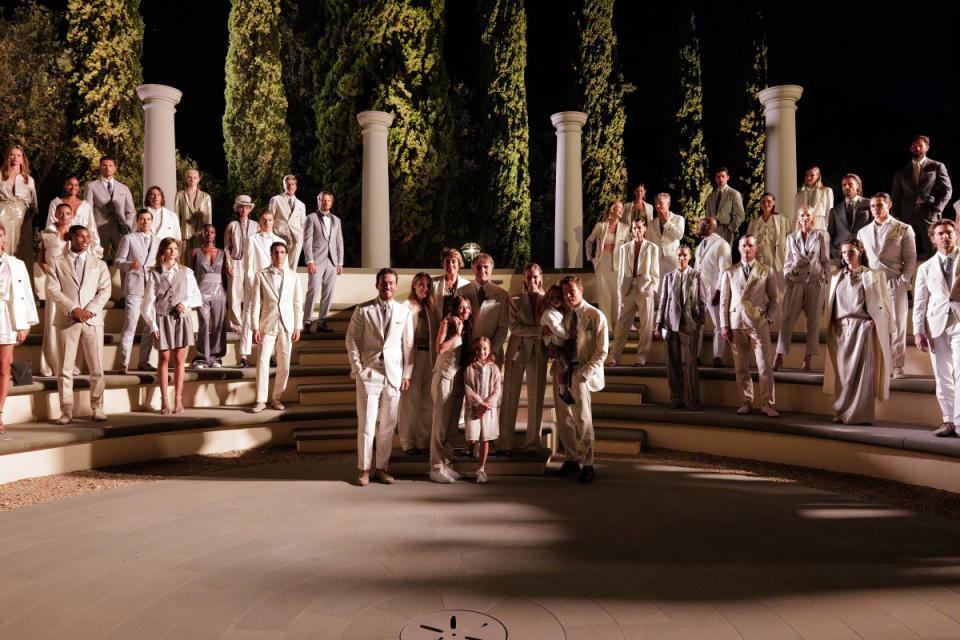
Photo: Courtesy of Brunello Cucinelli
With the help of his trusted translator Chiara, we discuss the origins of his love for fashion, how he built a multi-million-dollar empire out of a cashmere sweater and his approach to "humanistic capitalism". I didn't dare ask the king of cashmere about "quiet luxury," the so-pervasive-it's-unmentionable trend he helped pioneer (not intentionally, of course) with his luxurious, expensive, unbranded staples that populate the wardrobes of the rich and influential, fictional and not.
Truthfully, I didn't have to: Throughout his life and in his work, Cucinelli has consistently demonstrated a deep-seated respect and admiration for quality, which has served as a guiding value for the collections his namesake brand puts out, for the decisions he makes as a business owner and for the customers that are drawn to it all. You don't have to bring up luxury because it's just there, rooted in a desire to make things that are beautiful, both literally (great clothes) and figuratively (a business with employees that feel fulfilled, that feel appreciated, that are working in lock step to create something bigger than themselves).
Read on to learn how he's done it, and other highlights from our conversation.
Where does your interest in fashion come from?
When I was about 16, 17, I met my wife. She was running a retail store, so we would talk about fashion on a daily basis and do the buy together. That's how I took a liking to fashion. Then, at 22, 23, I started modeling for a very famous company that did tennis wear and ski wear called Ellesse — I was also the showroom model, and when you work as a showroom model, you're exposed to the everyday business. That's when I started learning the rudiments of fashion.
When I turned 25, I came up with this idea of manufacturing cashmere garments. I wanted to do 'made in Italy' products that were very high quality, with a bit of innovation. That's when I came up with the idea of dyeing cashmere for women, that was very sexy, shape-wise. I didn't want to make anything that would go to waste, that you would throw away... If you come to my home, on the ground floor, I keep all the different garments that I've been wearing since when I was 16, 17. I prefer to repair, to preserve. This idea of preserving, of keeping, of embellishing applies to fashion, but also to the restoration of the hamlet.
You were studying engineering when you dropped out to start your brand with those cashmere sweaters. Was there a specific moment that made you want to pivot completely from this path you were on to pursue fashion full-time?
I had never even touched cashmere — not once in my life — but I knew it was a synonym for luxury. Back then, we would wear Shetland wool garments; Shetland wool is very nice, but it's very rough on your skin. The first time I touched a brown cashmere men's pullover, I said, 'What's this soft thing?' I was just there playing cards with my friends at the local cafe, and on Monday morning, I decided to do this. That's how it came to me.
I went to a small cashmere supplier, and I asked him to give to me a small bag, just 20 kilos of raw material. I had no money. I said to him, 'I'm sorry, I can't pay for that.' He said, 'Don't worry about it. You will give me the money whenever you have it, in two, three months time, when your enterprise has started off.' He showed me that he believed in me. He believed in the youth.
This is also a culture of the small hamlet, where everybody knows everybody else, where there are relationships and everybody's willing to help.... If you come live in a big city, it's difficult to find such a network of support. Umbria has always been a very important knitwear district. I was dealing with cashmere, but I was surrounded by knitwear everywhere. It was a culture.
I didn't want to do men's — only women's, because there was cashmere for men in basic brown, grey colors, but never for ladies and never dyed. So I made six pullovers in colored cashmere.
When she was 22, my daughter Carolina would come to me every morning with a different idea for her profession. One day, she came and said, 'I want to work in a circus.' I said, 'Yes, great, why not? I welcome this idea. Let me talk to somebody I know from the circus.' Of course, I didn't know anyone in the circus... But everything she would throw at me, [I would say] 'Yes, that's a great idea.'
When I went to my dad when I was 25 and told him I wanted to make cashmere sweaters from now on, he said, 'May God be with you. I don't understand a single word of what you said, but may God be with you...' I think the parents should act like an accompanying figure, somebody that stands just behind, supervising, overseeing what you do, but never depriving the youth of their dream, because that's what they do. You can't kill their dreams.
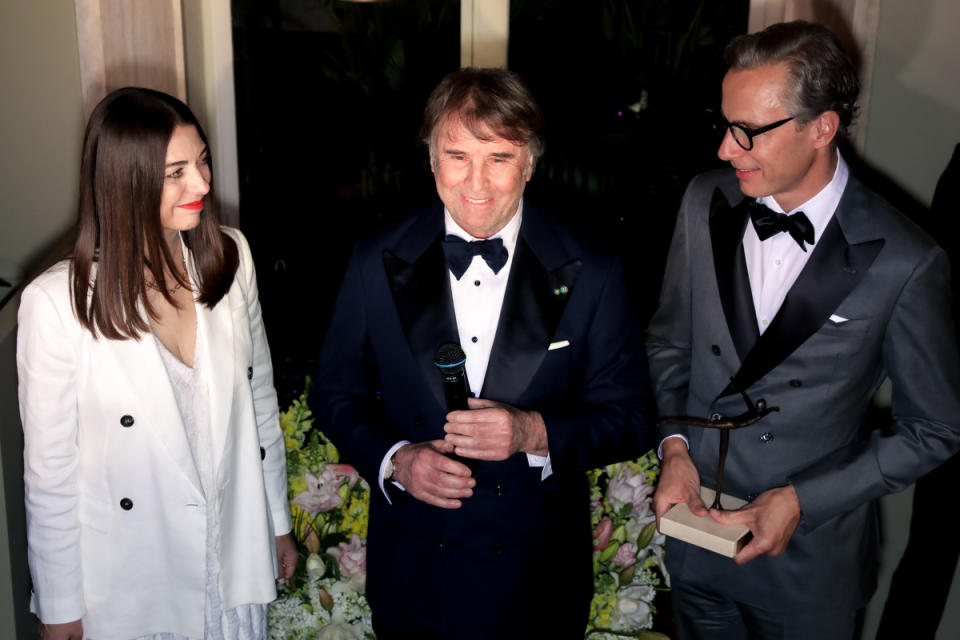
Photo: François Goizé/WWD via Getty Images
You dealt primarily in knitwear for the first few decades of your business. When and why did you expand into other categories?
It was in the year 2000, thanks to the Americans. It was and still is an American thing of wanting to buy the total look of a brand. For 20 years, we made knitwear, but my American clients would look at me and my style back then — I would wear my cargo pants, a tie, a blazer — and started asking for the total look. For men's, it was easy, because I just took a look at my wardrobe, my jackets, my coats, my trousers. Then, we started with ladies.
We switched from being just a knitwear manufacturing company to being a brand.
How did you translate the values of the knitwear that was already so successful for you into a total look? Were there certain qualities that you felt had to be present in every product you made?
Everything that came out of our factory needed to be extremely top-notch quality, first and foremost. Quality is something you can vouch for. Only then does taste come. You need taste, then you need identity.
I had a great teacher in Ralph Lauren. I remember, we went to visit him in his office in New York in 2019, and I greeted him by saying, 'Buongiorno, mio grande maestro. You were always a source of inspiration for me. I hope I never copied any of your designs.'
In our collection, you would never come up with a bright pop color in trousers or a blazer; it's always just the knitwear. That's when the no-logo philosophy or policy started: My idea was that, if you have a logo, it lasts less — with no logo, it can last for 100, 200 years.
Another part of the brand that encapsulates this idea of creating something that's going to last a long time is what you've built in Solomeo. You started developing the brand's presence in the hamlet in the late '80s. Why was it important to you to invest in a place where you could grow and where you could center your operations in such a way?
When I was about 30, I came across this life-changing statement by Jean-Jacques Rousseau, about how cities are tough to live in, and how we have to go back to the hamlets... Even before that, I had thought about Hadrian the Emperor, who said, 'I felt responsible for the beauty of the world.'
I myself come from the village. I always wanted to live and work in a village... Maybe in the past, it could be [seen as] not so efficient, because instead of having everything in a big factory, you're scattered in different residences, as it was in the beginning. But I would see cashmere, then see Solomeo, then see cashmere and Solomeo — I started wrapping my head around the idea of marrying the product and the place. Because the place plays a very important role, everywhere you go.
It was a financial issue, because I thought: If I go about restoring small, independent, individual residencies, in 30, 40 years time, they'll take on value, rather than losing it — unlike a factory that you build. You would look around and see many different warehouses or former factories that had lost all their value. I didn't want to end up like that. The idea of the hamlet restoration came from there.
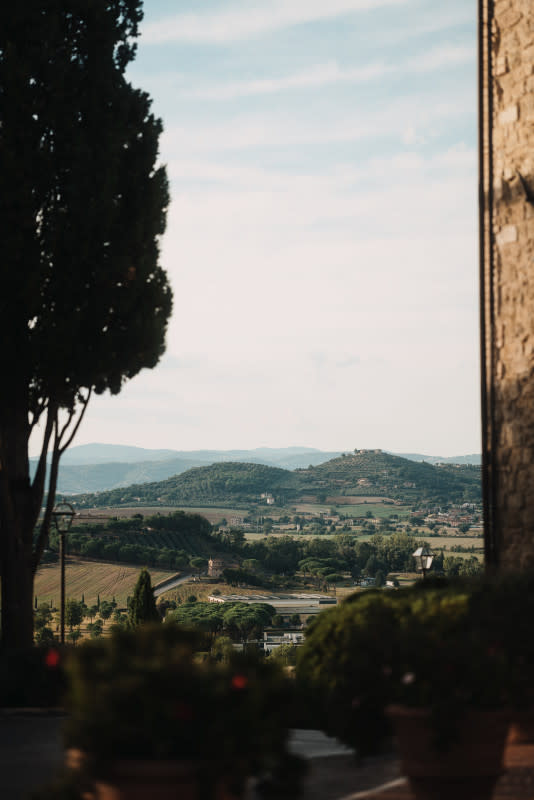
Photo: Courtesy of Brunello Cucinelli
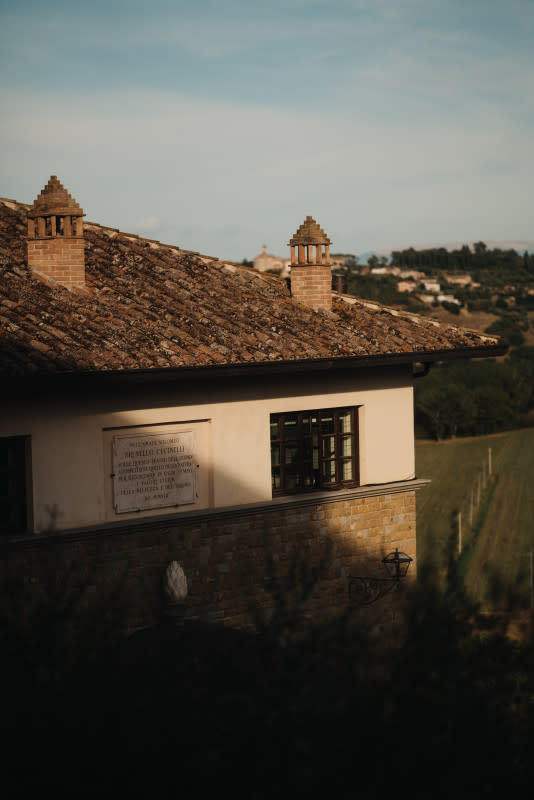
Photo: Courtesy of Brunello Cucinelli
What was the first step in this restoration?
The first project brought about many sleepless nights for me. I bought the tower of the Old Castle, dating back to 1391. The owner was a very wealthy, well-off man — a good man, too. I went to him and said, 'If you sell it to me, I will start restoring it completely, and it will still be standing in a thousand years' time.' You could tell he had a heart and was passionate about mankind and humanity... He invited me to dinner at his restaurant, and he tended to me, gave me freshly grated Parmesan... You could tell that he had a passion for quality.
At about 1:30 a.m., he said, 'I'm going to sell the tower to you,' and came to me with a heap of promissory notes to sign. I was signing one promissory note after the other, then I said, 'How am I going to pay off all this debt, all these promissory notes?' He told me when the time comes, we'll postpone — and that was the great joy for me. I got back home at 3:00 a.m. with all these promissory notes, and when I told [my wife] she said, 'Tough times lie ahead.'
I didn't sleep a wink that night. I got up at around 4:30 a.m. and started walking towards the castle and admiring the tower, saying, 'This is mine. I bought something dating back to 1391.' It was such a great feeling. I would raze my gaze and call the creator. See, 'creator' is something that applies to anybody... We have two very important saints in Umbria: St. Benedict and St. Francis. Basically, I would say to reach out and help me. It's a way of talking to yourself, talking to your soul.
You've spoken about your approach to business as "humanistic capitalism." How do you believe it has helped your brand's success and made it stronger?
I've always been informed by two different schools of thoughts. On the one hand, there are the Greeks — Solon, Pericles, Phidias, Aristotle, Socrates — who have trained me in beauty. On the other hand are the Romans, who were the founding fathers of law, as we know it today, with three main tenets: Live in honesty, don't harm anyone, to each their own. I find that these are the foundation of human life.
Also taking into account the way in which my dad and my siblings had been badly treated [at work], I wanted to set up a company where moral and economic dignity would rank first. I wanted my people to work surrounded by beauty, in beautiful places. I wanted them to make slightly more money than the average. And I wanted them to be treated as thinking souls. This is what humanistic capitalism is all about, and it goes hand-in-hand with a healthy, well-balanced profit.
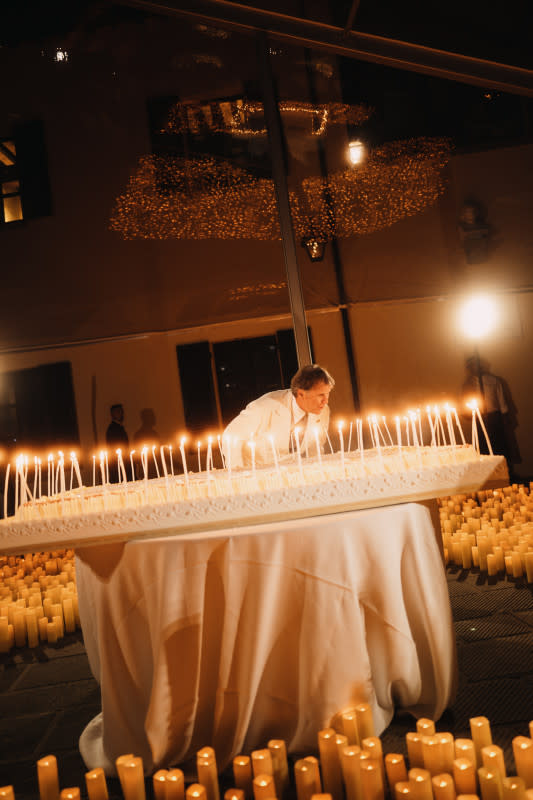
Photo: Courtesy of Brunello Cucinelli
In the fashion business, there's so much pressure coming from all directions — how you could make more money if you did X, Y, Z. How have you centered yourself in these values, in order to make decisions that not only align with this approach but help you grow as a brand?
This applies to all different industries, not just fashion — and for all human beings at that. The basic idea was: I want to give others what I would like to receive from others. That's it. You have to live and work as a good person.
We held our first meeting to discuss the Fall 2024 womenswear collection, and the first thing I said was, 'We need to lead a normal life.' We want to live as normal people, doing fair work, working a fair amount of hours. We have to work together to foster creativity and to show respect for everyone. We're all brothers in the world. I'm 70, and I can tell you that in life, you get back what you sow. What goes around comes around. It doesn't only have to do with money — it has to do with kindness: You provide kindness, you will receive kindness; you provide bounty, you will receive bounty. This is the law of life.
So much of your work has been about legacy, about building for the future. A great example of this is the series of schools you've built in Solomeo, to teach craftsmanship. What have they achieved so far, and what you hope they will achieve in the future?
The idea is always that of passing on, of handing down. In order to pass on and hand down, you need schools. That's why we set up schools for crafts, for arts, for theater, for music, for knitwear in Solomeo — to bequeath a culture for the next generations. I want to be some sort of small-scale teacher of creation, to leave this legacy.
In the first stage of your life, you learn. In the second, you do or make. The third is devoted to teaching. And that's what these schools embody. And this is true for every kind of industry, for every human being, for anything: You learn, you make, then you teach.
Want the latest fashion industry news first? Sign up for our daily newsletter.

